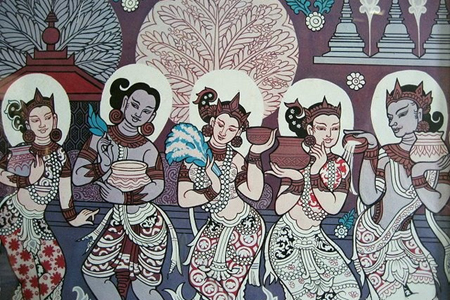The lives of kings, nobles and citizens of Bagan seemed involved mostly with religion: the building of temples, the maintenance and many ceremonies of consecration, etc. There were masons, carpenters, and artists who were generously paid in gold, silver, silks, and rice. There were farmers who planted rice or had toddy plantations for the juice, drunk fresh, fermented or made into palm sugar. Cottage industries turned out beautiful pipes made of black clay which both men and women smoked; potters turned out utensils and the shards of their wares layer the earth of Bagan. They lived in villages named Min Nanthu, Wetkyi In, Pwa Saw, and Myinkaba, places that still exist to this day. They bred cattle, horses or goats, cutting grass for their feed as they still do today.
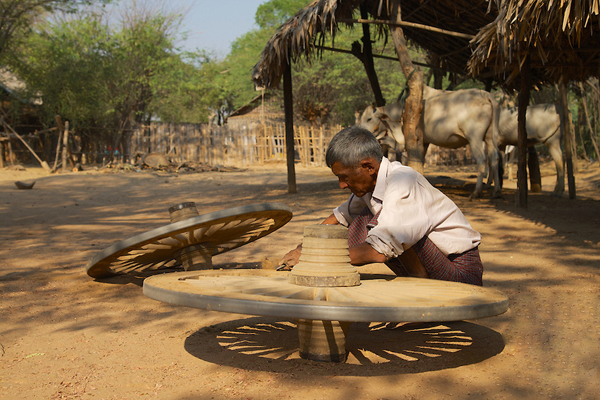
Goldsmiths made exquisite ornaments and jewelry, and artisans produced delicate-looking but strong lacquerware. They celebrated at pagoda festivals, annual affairs or special ceremonies on the consecration of new temples and monasteries.
Stone inscriptions and statements written in ink on temple walls not only recorded the data concerning the constructions but also gave detailed accounts of society.
The data on stone or written in ink on temple walls range from plans of a palace, lists of offerings, payment made to masons and painters, records of court cases or inheritances, a donation to pagodas of land or slaves. The donations come with wishes for the merits done, usually for Enlightenment or reaching Nirvana. Many also specified the punishments to fall on those who desecrate their temples. One princess donated slaves and property to a temple on behalf of her mother and her inscription dated 1165 concluded with a curse that whoever not conserving her temple, slaves or donated property but "leaves then defective or in ruin, though they are her own children or grandchildren: may the food they eat, the water they drink and the house they live in poison them...and with a hundred spears may they be pierced."
Another left a curse that if anyone should desecrate the temple, "by what they eat or wore or to where they go, may they be poisoned; may their lives be short and worthless, their bodies leprous and their existence hereafter is in hell."
However, there are a hundredfold more messages with pious contentment and compassionate intent.
The elegance of Bagan era literature can be seen in many of the inscriptions written in prose but with the grace of poetry One example is the inscription of Kyansittha (r.1084-1112) at the Shwezigon Pagoda: "...virgin daughters of princes, bright with all manner of jewels and fragrant with jasmine flowers shall attend him . during his reign mushrooms, bamboo shoots, flowers, and fruits shall abound ...young children who are learning to eat cake with their fingers shall behave nicely like their elders...poor old women who sell pots shall get high prices...farmers shall fill their barns and granaries with paddy, millet, and all manner of grain ".
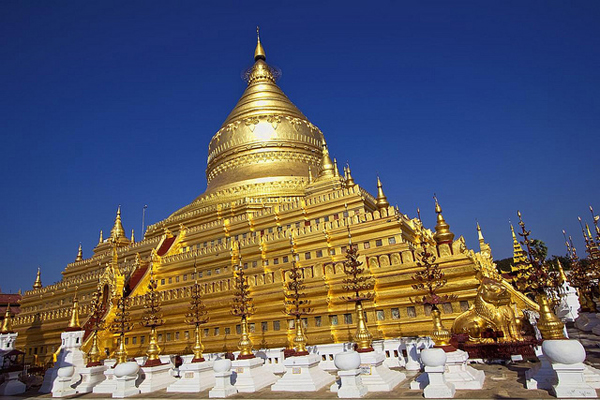
Rice for the Bagan populace was grown further north in the fertile Kyaukse area near present-day Mandalay, watered with many canals. On the arid plains of Bagan, the economy is still based on toddy palm orchards as it has been for centuries. Potters made great strides in their craft, for their green glaze was unlike any in the SE Asia region, and many abandoned kilns have been found.
One industry that has flourished for as long as the toddy palms stood was the making of lacquer-ware; the lacquer was not derived from insects but from the sap of the Melanhorrea usitata tree. The primary colors were obtained from nature such as yellow and red encased in river rocks and blue from the Indigo plant. Green, however, was not easily protected from oxidization until many centuries later.
Although there is no record of how the knowledge of lacquerware making entered Myanmar, it is possible that the Pyu race brought it into Bagan. They had diplomatic ties with people living in China in a region called Yun, people who excelled in lacquer products. To this day lacquer is known in Bamar as Yun. The strong yet flexible resin is still used by Bagan craftsmen and although lacquer-ware is produced in other places, it remains the pride of Bagan. So lacquer artisans continue to be the mainstay of Bagan's economy. They still use ancient methods, crafting every step by hand. Age-old designs are scratched out with rapid strokes of a metal stylus and then filled with organic dyes. Each coat of lacquer is dried and allowed to set for weeks. Tail hairs of horses are woven between thin strips of bamboo to make cups that are flexible enough to be squeezed.
Village headmen or at times head women were heredity administrators. Lands donated to temples and monasteries were leased out to farmers who paid 10% of their earnings to the trustees of the temples or monasteries. If cattle strayed onto this land and no claimants turned up after three years, the leader of the land and the temple shared in the proceeds of the sale of said cattle.
The judicial system was well-regulated with civil and criminal courts of various levels. Hearsay evidence was not accepted, and appeals could be made. The litigators swore on Buddhist texts as they still do or on Buddha images. By law people who wished to donate land or slaves to religion must request permission of the king. On the other hand, those who had no lands but wished to donate could ask the king to grant him what he needed.
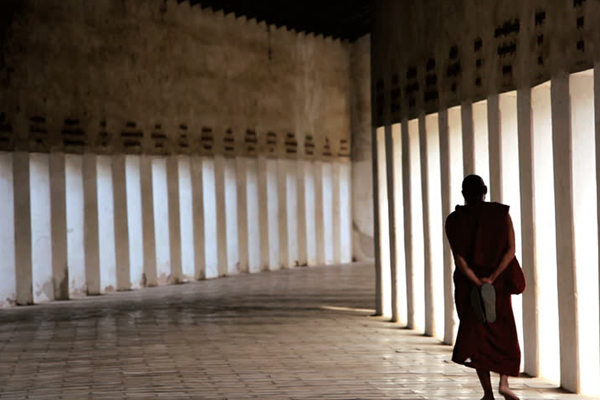
People earned merit by building or supporting the upkeep of pagodas or monasteries and in holding religious ceremonies in the same way they do nowadays. One stone inscription recorded that "my son became a monk...a silver Buddha and 1000 bowls filled with cooked rice were offered to monks... a well and water tank were dug...slaves, cattle and property donated."
The tradition of becoming a novice or monk is strongly alive today. Once taking a Bagan tour, you will have a chance to capture the popular image of many young novices on the street especially in the morning when they call for the morning alms. During the Bagan era, monks were called Bhikkhu and the women could become Bhikkuni, a higher level than a nun and equal to the Bhikkhu. The tradition had existed since the time of the Buddha but disappeared altogether in Myanmar after the end of Bagan.
One lady of court had a stone inscribed to commemorate her merit, with words that explained the tenets of Buddhism: I wish to abandon a body oppressed by countless miseries: of rebirth, of old age, of death, of living with those we do not love, of separation from those we love, and of not getting what we want. I long to achieve the noble bliss of Nirvana, that is free of all miseries. With this desire, I gave my precious gold, silver and other treasures to build a monastery. I gave all my fields, gardens and slaves bar none, for the use of the monks who are pupils of the Lord, and who dwell in the monastery; they who are pure in piety and ever-seeking the Three Graces of virtue, concentration, and understanding."
Buddhism is a path of detaching oneself from the lures of materialism and personal attachments that can only bring misery and to replace it with compassionate love for all. Therefore Buddhist society has no formalized rituals but many exist due to the fact that Brahmin astrologers were serving the kings of SE Asia for centuries For court rituals such as coronations or for donation ceremonies they oversaw the details and thus many Hindu practices became part of ceremonial rituals, not only in Myanmar but in other SE Asian countries as well.
It was not uncommon for the wealthy pagoda builder to donate slaves to sweep the grounds, to replenish the flower vases and do any repairs needed. Although enslaved by poverty, birth, and debts or as prisoners of war, slaves had the rights to be fed and treated well, to own land for farming and to buy back their freedom. If the owners could no longer feed them, they were free to leave and work elsewhere.
As seen on a few stone inscriptions some donors offered themselves and family members as slaves. One official with the title Thin Gyi Abhinantasu donated himself, wife and two daughters as pagoda slaves together with another five slaves and 9 acres of land to a pagoda which he had gilded. The ceremony of consecration and offering food was attended by an abbot and one hundred monks.
Women of Bagan worked as judges, head women of villages, record keepers, merchants, artists, weavers or scribes. One honorable position was of wet-nurse to royal babies; only young women of high birth were chosen for this position. Narathiha Pati (r.1254-1287) granted land, plus 1000 slaves and 1000 cows as "the price of the milk I drank" to his old wet-nurse Oh Ponsan.
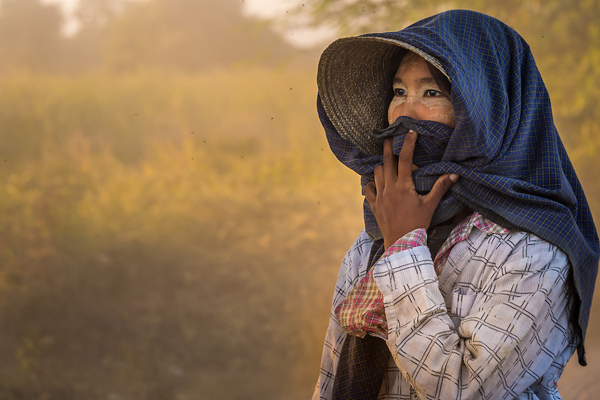
According to customary laws still in use today, Bagan-era women could administrate their own property even in marriage and had the right of inheritances equal to men. Buddhist men have the right to have more than one wife or to keep mistresses, and although women could not do the same, widows have the right to remarry. She could also sue for divorce and retain the property she brought into the marriage, splitting equally what was gained during their married life. In spite of the men's polygamy rights, the Myanmar women manage, in this highly matriarchal culture, to wield power from behind the scenes. The Bagan era had its share of powerful queens as did the periods that followed.
One great queen, both beautiful and wise, was Pwa Saw, consort of King Usana (r.1250-1254) and then of King Narathiha Pati (r.1254- 1287) However she was not the farmer's daughter as legend has it, but a king's daughter by a minor queen and she lived to influence the kingdom of Pinya that rose after the fall of Bagan.
Her mother-in-law was also known by the same name; this Queen Pwa Saw, consort of Kya Swar (r.1235-1250), mother of Usana and grandmother of Narathiha Pati, made a donation during her grandson's reign in the early 13th century. She inscribed a prayer that before she attained Nirvana, "by virtue of the work of merit I have done on such a big scale, I wish to be long-lived, free from sickness, beautiful, sweet-voiced and well-proportioned in limbs. Beloved, respected and admired by all men and spirits. I wish to be great through my power, influence, retinue and fame."
She gave an honest declaration in a time when it was more common to inscribe ritualistic prayers such as wishing for Nirvana. Another unusual prayer was made by a minor queen of Narathiha Pati, who gave her name only as 'daughter of Theingathu', a nobleman at court. It would seem she abhorred court intrigues and jealousies.
She built a monastery in 1266 and in her inscription, she stated her wishes that her merits be "shared by the king, ministers, queens, ladies of court and all beings, and that they be easily contented, not of a lustful mind and without anger; but with compassion, learning and insight to see far; without envy and with generosity; with faithfulness and without betrayal; with awareness and without forgetfulness; and that they live their cycle of lives in Samsara filled with goodness and be present at the coming of the Mettriya Buddha the Future One and thus attain Nirvana."
Moreover, her view in separating learning and insight 'to see far seemed to mean that to be educated was not enough: one needed to have insightful reasoning power. Her remark upon forgetfulness and awareness was an acknowledgment of the Buddhist concept that those who live without awareness are like cattle that know nothing but to sleep, eat and fornicate. She was a true Buddhist and a true daughter of Bagan, who advocated harmony of living without anger, lust, and envy.

